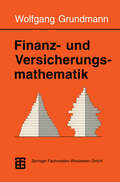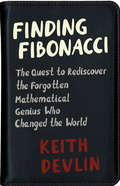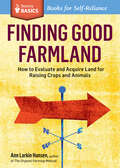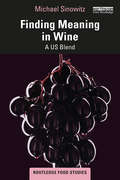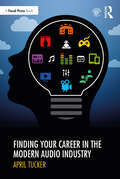- Table View
- List View
Finanzierung für Ingenieure (essentials)
by Ekbert HeringDie meisten Ingenieure in der Praxis werden vor Finanzierungsaufgaben gestellt und müssen hierfür die optimalen Finanzierungsmöglichkeiten bereitstellen. Deshalb werden in diesem Band die Finanzierungsarten und die Finanzierungsinstrumente vorgestellt. Es wird gezeigt, welche wichtigen Informationen eine Finanzanalyse bieten kann und wie eine Finanzplanung für ein Unternehmen erstellt wird.
Finanzierung und Bilanzierung in der Bauwirtschaft: Basel II - neue Vertragsmodelle - International Financial Reporting Standards (Leitfaden des Baubetriebs und der Bauwirtschaft)
by Dipl.-Kfm. Dieter Jacob Constanze StuhrDieser einzigartige Leitfaden gibt einen kompakten Überblick erfolgreicher Finanzierung und Bilanzierung in der Bauwirtschaft. Das aktuelle Thema ist dabei in zwei Schwerpunkte unterteilt. Im ersten Teil berücksichtigen die Autoren finanzielle Besonderheiten der Bauwirtschaft - auch im Auslandsbau - und gehen ausführlich auf firmen- als auch projektbezogene Aspekte ein. Im zweiten Schwerpunkt erläutert das Buch umfassend die richtige Einzel- und Konzernbilanzierung. Neben deutschem Handelsrecht gewinnen die internationalen Bilanzierungsstandards wie IFRS und US-GAAP immer mehr an Bedeutung. Nicht unwesentlich beeinflusst auch der Basel II-Prozess die Thematik. Das Buch vermittelt Ingenieuren und Architekten dazu ein breites Know-how und ist eine sichere Hilfestellung auf diesem Gebiet.
Finanzierung und Bilanzierung in der Bauwirtschaft: Basel II/III - neue Finanzierungsmodelle - IFRS - BilMoG (Leitfaden des Baubetriebs und der Bauwirtschaft)
by Dipl.-Kfm. Dieter Jacob Constanze StuhrDieser einzigartige Leitfaden gibt einen kompakten Überblick erfolgreicher Finanzierung und Bilanzierung in der Bauwirtschaft. Das aktuelle Thema ist dabei in zwei Schwerpunkte unterteilt. Im ersten Teil berücksichtigen die Autoren finanzielle Besonderheiten der Bauwirtschaft - auch im Auslandsbau - und gehen ausführlich auf firmen- als auch projektbezogene Aspekte ein. Im zweiten Schwerpunkt erläutert das Buch umfassend die richtige Einzel- und Konzernbilanzierung. Die 2. Auflage wurde vollständig überarbeitet und berücksichtigt die aktuellen Entwicklungen in diesem Bereich.
Find Your Way Around JCT 98 (Find Your Way Round... S. Ser.)
by Richard WoolleyStandard contracts published for use in the construction industry are complex documents and contain many inter-related clauses. This book will enable the user to find easily not just the main references dealing with a particular topic, but also the related clauses and references. In facing any contractual problem, it is the practitioner's primary duty to discover all the relevant references and make a judgement, which is not possible until all references have been covered. This book identifies the main topics which a practitioner will encounter, giving all the references to each topic which may be scattered throughout the document and a one-line signpost to indicate the contents of each reference.
Find Your Way Around JCT 98
by Richard WoolleyStandard contracts published for use in the construction industry are complex documents and contain many inter-related clauses. This book will enable the user to find easily not just the main references dealing with a particular topic, but also the related clauses and references. In facing any contractual problem, it is the practitioner's primary duty to discover all the relevant references and make a judgement, which is not possible until all references have been covered. This book identifies the main topics which a practitioner will encounter, giving all the references to each topic which may be scattered throughout the document and a one-line signpost to indicate the contents of each reference.
Finding Fibonacci: The Quest to Rediscover the Forgotten Mathematical Genius Who Changed the World
by Keith DevlinA compelling firsthand account of Keith Devlin's ten-year quest to tell Fibonacci's storyIn 2000, Keith Devlin set out to research the life and legacy of the medieval mathematician Leonardo of Pisa, popularly known as Fibonacci, whose book Liber abbaci has quite literally affected the lives of everyone alive today. Although he is most famous for the Fibonacci numbers—which, it so happens, he didn't invent—Fibonacci's greatest contribution was as an expositor of mathematical ideas at a level ordinary people could understand. In 1202, Liber abbaci—the "Book of Calculation"—introduced modern arithmetic to the Western world. Yet Fibonacci was long forgotten after his death, and it was not until the 1960s that his true achievements were finally recognized.Finding Fibonacci is Devlin's compelling firsthand account of his ten-year quest to tell Fibonacci's story. Devlin, a math expositor himself, kept a diary of the undertaking, which he draws on here to describe the project's highs and lows, its false starts and disappointments, the tragedies and unexpected turns, some hilarious episodes, and the occasional lucky breaks. You will also meet the unique individuals Devlin encountered along the way, people who, each for their own reasons, became fascinated by Fibonacci, from the Yale professor who traced modern finance back to Fibonacci to the Italian historian who made the crucial archival discovery that brought together all the threads of Fibonacci's astonishing story.Fibonacci helped to revive the West as the cradle of science, technology, and commerce, yet he vanished from the pages of history. This is Devlin's search to find him.
Finding Fibonacci: The Quest to Rediscover the Forgotten Mathematical Genius Who Changed the World
by Keith DevlinA compelling firsthand account of Keith Devlin's ten-year quest to tell Fibonacci's storyIn 2000, Keith Devlin set out to research the life and legacy of the medieval mathematician Leonardo of Pisa, popularly known as Fibonacci, whose book Liber abbaci has quite literally affected the lives of everyone alive today. Although he is most famous for the Fibonacci numbers—which, it so happens, he didn't invent—Fibonacci's greatest contribution was as an expositor of mathematical ideas at a level ordinary people could understand. In 1202, Liber abbaci—the "Book of Calculation"—introduced modern arithmetic to the Western world. Yet Fibonacci was long forgotten after his death, and it was not until the 1960s that his true achievements were finally recognized.Finding Fibonacci is Devlin's compelling firsthand account of his ten-year quest to tell Fibonacci's story. Devlin, a math expositor himself, kept a diary of the undertaking, which he draws on here to describe the project's highs and lows, its false starts and disappointments, the tragedies and unexpected turns, some hilarious episodes, and the occasional lucky breaks. You will also meet the unique individuals Devlin encountered along the way, people who, each for their own reasons, became fascinated by Fibonacci, from the Yale professor who traced modern finance back to Fibonacci to the Italian historian who made the crucial archival discovery that brought together all the threads of Fibonacci's astonishing story.Fibonacci helped to revive the West as the cradle of science, technology, and commerce, yet he vanished from the pages of history. This is Devlin's search to find him.
Finding Good Farmland: How to Evaluate and Acquire Land for Raising Crops and Animals. A Storey BASICS® Title (Storey Basics)
by Ann Larkin HansenAnn Larkin Hansen shows you how to identify and refine your specific land needs using checklists and questionnaires.
Finding Meaning in Wine: A US Blend (Routledge Food Studies)
by Michael SinowitzThis book examines controversies in American wine culture and how those controversies intersect with and illuminate current academic and cultural debates about the environment and about interpretation. With a specific focus on the United States of America, the methods that we use to discuss literature and other art are applied to wine-making and wine culture. The book explores the debates about how to evaluate wine and the problems inherent in numerical scoring as well as evaluative tasting notes, whether winemakers can be artists, the discourse in wine culture involving natural wine and biodynamic farming, as well as how people judge what makes a wine great. These interpretative commitments illuminate an underlying metaphysics and allegiance to a culture of reason or feeling. The discussions engage with a broad range of writers and thinkers, such as Roland Barthes, Susan Sontag, Louis Menand, Michael Pollan, Greg Garrard, John Guillory, Amitov Ghosh, Pierre Bourdieu, and Barbara Herrnstein-Smith. The book draws upon not only a number of texts produced by wine critics, wine writers, literary critics and theorists but also extensive interviews with wine writers and multiple California winemakers. These interviews contribute to a unique reflection on wine and meaning. This book will be of great interest to readers looking to learn more about wine from cultural, literary, and philosophical perspectives.
Finding Meaning in Wine: A US Blend (Routledge Food Studies)
by Michael SinowitzThis book examines controversies in American wine culture and how those controversies intersect with and illuminate current academic and cultural debates about the environment and about interpretation. With a specific focus on the United States of America, the methods that we use to discuss literature and other art are applied to wine-making and wine culture. The book explores the debates about how to evaluate wine and the problems inherent in numerical scoring as well as evaluative tasting notes, whether winemakers can be artists, the discourse in wine culture involving natural wine and biodynamic farming, as well as how people judge what makes a wine great. These interpretative commitments illuminate an underlying metaphysics and allegiance to a culture of reason or feeling. The discussions engage with a broad range of writers and thinkers, such as Roland Barthes, Susan Sontag, Louis Menand, Michael Pollan, Greg Garrard, John Guillory, Amitov Ghosh, Pierre Bourdieu, and Barbara Herrnstein-Smith. The book draws upon not only a number of texts produced by wine critics, wine writers, literary critics and theorists but also extensive interviews with wine writers and multiple California winemakers. These interviews contribute to a unique reflection on wine and meaning. This book will be of great interest to readers looking to learn more about wine from cultural, literary, and philosophical perspectives.
Finding Solutions of the 21st Century Transportation Problems Through Research and Innovations: Proceedings of the 6th GeoChina International Conference on Civil & Transportation Infrastructures: From Engineering to Smart & Green Life Cycle Solutions -- Nanchang, China, 2021 (Sustainable Civil Infrastructures)
by Zahid Hossain Musharraf Zaman Jiupeng ZhangThis volume presents challenges in transportation infrastructures and geotechniques, advancements in recycling, soil stabilization and reinforcement technologies, and assessments of roadway conditions using modern tools and techniques. The articles presented in this volume focus on fundamental investigations on various aspects of civil engineering materials and structures. The scope of this volume is the application of findings for solving problems in geotechnical, pavement, concrete and transportation engineering using through smart, green and emerging techniques. The primary audience of this work will be researchers, professionals, and practitioners around the world. This volume is based on contributions to the 6th GeoChina International Conference on Civil & Transportation Infrastructures: From Engineering to Smart & Green Life Cycle Solutions -- Nanchang, China, 2021.
Finding Your Career in the Modern Audio Industry
by April TuckerFinding Your Career in the Modern Audio Industry equips the reader with the skills they need to turn an interest in audio, sound, or music technology into a career. This book provides insight for aspiring professionals seeking audio-related opportunities in entertainment, technology, education, and more. In the audio industry, there is typically a gap between those in-training and those with professional (and financially sustainable) careers. This book bridges the information gap, offering practical and real-world advice to those in this volatile stage of their career. Including 70+ interviews with professionals from over 20 countries, Finding Your Career in the Modern Audio Industry offers insight into how others (across the industry and the world) have applied entrepreneurial thinking, problem-solving, and creative solutions to build their careers. Including international case studies and interviews with diverse professionals, Finding Your Career in the Modern Audio Industry is essential reading for anyone taking their first steps into an audio-related field.
Finding Your Career in the Modern Audio Industry
by April TuckerFinding Your Career in the Modern Audio Industry equips the reader with the skills they need to turn an interest in audio, sound, or music technology into a career. This book provides insight for aspiring professionals seeking audio-related opportunities in entertainment, technology, education, and more. In the audio industry, there is typically a gap between those in-training and those with professional (and financially sustainable) careers. This book bridges the information gap, offering practical and real-world advice to those in this volatile stage of their career. Including 70+ interviews with professionals from over 20 countries, Finding Your Career in the Modern Audio Industry offers insight into how others (across the industry and the world) have applied entrepreneurial thinking, problem-solving, and creative solutions to build their careers. Including international case studies and interviews with diverse professionals, Finding Your Career in the Modern Audio Industry is essential reading for anyone taking their first steps into an audio-related field.
Finding Your Online Voice: Stories Told by Experienced Online Educators
by J. Michael SpectorFinding Your Online Voice offers a thought-provoking discussion of innovative approaches to technology-based distance education. Editor J. Michael Spector focuses on how highly experienced teachers conceptualize and organize online classes. Best practices and guidelines for effective online teaching as well as a set of instructor skills speci
Finding Your Online Voice: Stories Told by Experienced Online Educators
by J. Michael SpectorFinding Your Online Voice offers a thought-provoking discussion of innovative approaches to technology-based distance education. Editor J. Michael Spector focuses on how highly experienced teachers conceptualize and organize online classes. Best practices and guidelines for effective online teaching as well as a set of instructor skills speci
Fine- and Coarse-Grain Reconfigurable Computing
by M. Valero Stamatis Vassiliadis Y. Patt J. Smith Dimitrios SoudrisThe basic concepts and building blocks for the design of Fine- (or FPGA) and Coarse-Grain Reconfigurable Architectures are discussed in this book. Recently-developed integrated architecture design and software-supported design flow of FPGA and coarse-grain reconfigurable architecture are also described.
Fine-Grained Image Analysis: Modern Approaches (Synthesis Lectures on Computer Vision)
by Xiu-Shen WeiThis book provides a comprehensive overview of the fine-grained image analysis research and modern approaches based on deep learning, spanning the full range of topics needed for designing operational fine-grained image systems. The author begins by providing detailed background information on FGIA, focusing on recognition and retrieval. The author also provides the fundamentals of convolutional neural networks to further make it easier for readers to understand the technical content in the book. The book introduces the main technical paradigms, technological developments, and representative approaches of fine-grained image recognition and fine-grained image retrieval. The author covers multiple popular research topics and includes cross-domain knowledge. The book also highlights advanced applications and topics for future research.
Fine Particles Science and Technology: From Micro to Nanoparticles (NATO Science Partnership Subseries: 3 #12)
by E. PelizzettiFine Particles Science and Technology deals with the preparation, characterization and technological applications of monodisperse particles in the micro to nano size range. A broad view of this frontier field is given, covering understanding the mechanisms by which uniform fine particles are formed and the search for new processes; the mechanism of the precipitation technique, requiring knowledge of the relationship between the complex solution chemistry and the products formed; the sequence of events leading to the formation of monodisperse colloids. The following topics are presented: microparticles, nanoparticles, applications in the preparation of materials, synthesis and properties, environmental applications, and many others.
Fine Pitch Surface Mount Technology: Quality, Design, and Manufacturing Techniques
by Phil MarcouxFine pitch high lead count integrated circuit packages represent a dramatic change from the conventional methods of assembling electronic components to a printed interconnect circuit board. To some, these FPTpackages appear to bean extension of the assembly technology called surface mount or SMT. Many of us who have spent a significant amount of time developing the process and design techniques for these fine pitchpackages haveconcluded that these techniquesgobeyondthose commonly useed for SMT. In 1987 the presentauthor, convincedofthe uniqueness ofthe assembly and design demands ofthese packages, chaired ajoint committee where the members agreed to use fine pitch technology (FPT) as the defining term for these demands. The committee was unique in several ways, one being that it was the first time three U. S. standards organizations, the IPC (Lincolnwood, IL), theEIA(Washington, D. C. ),and theASTM (Philadelphia),cametogether tocreate standards before a technology was in high demand. The term fine pitch technology and its acronym FPT have since become widely accepted in the electronics industry. The knowledge of the terms and demands of FPT currently exceed the usage of FPT packaged components, but this is changing rapidly because of the size, performance, and cost savings of FPT. I have resisted several past invitations to write other technical texts. However, I feel there are important advantages and significant difficulties to be encountered with FPT.
Fine–Kinney-Based Fuzzy Multi-criteria Occupational Risk Assessment: Approaches, Case Studies and Python Applications (Studies in Fuzziness and Soft Computing #398)
by Muhammet Gul Suleyman Mete Faruk Serin Erkan CelikThis book presents a number of approaches to Fine–Kinney–based multi-criteria occupational risk-assessment. For each proposed approach, it provides case studies demonstrating their applicability, as well as Python coding, which will enable readers to implement them into their own risk assessment process. The book begins by giving a review of Fine–Kinney occupational risk-assessment methods and their extension by fuzzy sets. It then progresses in a logical fashion, dedicating a chapter to each approach, including the fuzzy best and worst method, interval-valued Pythagorean fuzzy VIKOR and interval type-2 fuzzy QUALIFLEX. This book will be of interest to professionals and researchers working in the field of occupational risk management, as well as postgraduate and undergraduate students studying applications of fuzzy systems.
FinFETs and Other Multi-Gate Transistors (Integrated Circuits and Systems)
by J. P. ColingeThis book explains the physics and properties of multi-gate field-effect transistors (MuGFETs), how they are made and how circuit designers can use them to improve the performances of integrated circuits. It covers the emergence of quantum effects due to the reduced size of the devices and describes the evolution of the MOS transistor from classical structures to SOI (silicon-on-insulator) and then to MuGFETs.
The Finger Millet Genome (Compendium of Plant Genomes)
by Anil Kumar Salej Sood B. Kalyana Babu Sanjay Mohan Gupta B. Dayakar RaoThis book is the first comprehensive compilation of deliberations on domestication, genetic and genomic resources, breeding, genetic diversity, molecular maps & mapping of important biotic stress as well as nutritional quality traits, genome sequencing, comparative genomics, functional genomics and genetic transformation. The economic, nutritional and health benefits especially antioxidants mediated antiaging effects of finger millet are also discussed. It also presents the input use efficiency, wide adaptation, post-harvest processing and value addition of the crop. Altogether, the book contains about 300 pages over 16 chapters authored by globally reputed experts on the relevant field in this crop. This book is useful to the students, teachers and scientists in the academia and relevant private companies interested in genetics, pathology, molecular genetics and breeding, genetic engineering, structural and functional genomics and nutritional quality aspects of the crop. This book is also useful to seed and pharmaceutical industries.
Fingerprinting Techniques in Food Authentication and Traceability (Food Analysis & Properties)
by K. S. Siddiqi Leo M.L. NolletThere is an increasing interest by consumers for high-quality food products with a clear geographical origin. With these products in demand, suitable analytical techniques are needed for the quality control. Current analytical approaches are mass spectrometry techniques, spectroscopic techniques, separation techniques, and others. Fingerprinting Techniques in Food Authentication and Traceability discusses the principles of the techniques together with their advantages and drawbacks, and reported applications concerning geographical authenticity. A combination of methods analyzing different types of food compounds seems to be the most promising approach to establish the geographical origin. The abundant acquired data are analyzed by chemometrics. Producing safe and high-quality food is a prerequisite to ensure consumer health and successful domestic and international trade, and is critical to the sustainable development of national agricultural resources. Systems to trace food or feed products through specified stages of production, processing, and distribution play a key role in assuring food safety. Analytical techniques that enable the provenance of food to be determined provide an independent means of verifying traceability systems and also help to prove product authenticity, to combat fraudulent practices and to control adulteration, which are important issues for economic, religious, or cultural reasons. Proof of provenance has become an important topic in the context of food safety, food quality, and consumer protection in accordance with national legislation and international standards and guidelines.
Fingerprinting Techniques in Food Authentication and Traceability (Food Analysis & Properties)
by K. S. Siddiqi Leo M.L. NolletThere is an increasing interest by consumers for high-quality food products with a clear geographical origin. With these products in demand, suitable analytical techniques are needed for the quality control. Current analytical approaches are mass spectrometry techniques, spectroscopic techniques, separation techniques, and others. Fingerprinting Techniques in Food Authentication and Traceability discusses the principles of the techniques together with their advantages and drawbacks, and reported applications concerning geographical authenticity. A combination of methods analyzing different types of food compounds seems to be the most promising approach to establish the geographical origin. The abundant acquired data are analyzed by chemometrics. Producing safe and high-quality food is a prerequisite to ensure consumer health and successful domestic and international trade, and is critical to the sustainable development of national agricultural resources. Systems to trace food or feed products through specified stages of production, processing, and distribution play a key role in assuring food safety. Analytical techniques that enable the provenance of food to be determined provide an independent means of verifying traceability systems and also help to prove product authenticity, to combat fraudulent practices and to control adulteration, which are important issues for economic, religious, or cultural reasons. Proof of provenance has become an important topic in the context of food safety, food quality, and consumer protection in accordance with national legislation and international standards and guidelines.
